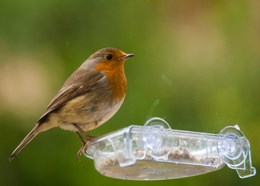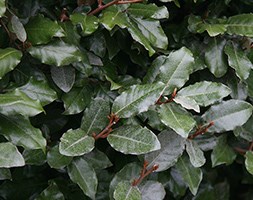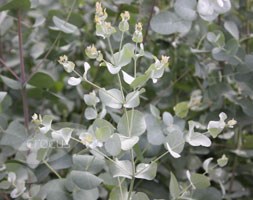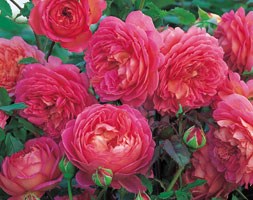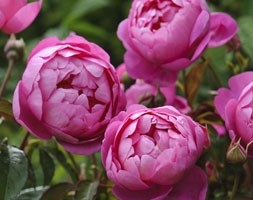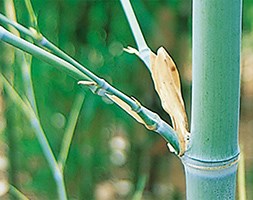Price reductions at Crocus
by Sarah - September 27th, 2013.Filed under: Crocus, Price Reductions.
Crocus reduced the price on these items today
Window bird treat tray was £5.99 now £4.99
This clear window bird feeder is a great way to see the birds close up. It clings to any window surface and is perfect for allowing full view of the birds without any obscuring plastic to hide your view. It is ideal for mealworms, nuts and seed mix. We think this feeder goes perfectly with the I love robins seed mix as listed below: Measurements: Height 2cm approx Length 12cm Width 10cm
Elaeagnus x ebbingei (oleaster) was £10.99 now £8.99
Position: full sun or partial shade Soil: fertile, well-drained soil Rate of growth: average to fast-growing Flowering period: October and November Flower colour: creamy-white Other features: tolerates dry soil and salt-laden coastal winds Hardiness: fully hardy Lustrous, dark green leaves with silvery undersides and fragrant, creamy- white autumn flowers. This versatile, shade-tolerant, evergreen shrub is equally at home in the shrub border or grown as an informal hedge. The plain green foliage is an excellent foil for ornamental or feature plants and for screening or linking areas of the garden. Garden care: To keep hedging specimens tidy in late summer cut back long or misplaced shoots using secateurs. Remove any plain green-leaved shoots as soon as they appear, cutting them back to the origin.
Eucalyptus gunnii (cider gum) was £14.99 now £11.99
Position: full sun Soil: neutral to slightly acidic soil that doesn’t dry out Rate of growth: fast-growing Flowering period: July to October Flower colour: white to cream, but not often seen in Britain Other features: usually grown with multiple stems as it seems to cope with strong winds better Hardiness: borderline hardy (may need winter protection) A magnificent tree with flaking bark in shades of grey, cream, green and brown. It has silvery-blue, rounded young leaves which give way to long, glaucous, sickle-shaped adult foliage. It is probably the most well-known gum in this country as it is often seen in milder garden, where it is completely hardy except in abnormally cold winters. Garden care: Requires minimal pruning if grown as a tree, removing any broken, diseased or crossing branches in late autumn or winter. For the best juvenile foliage, prune in early spring cutting back the stems to two or three buds above the base. When planting incorporate lots of well-rotted garden compost in the planting hole and stake firmly.
Photinia x fraseri Pink Marble (‘Cassin’) (photinia) was £12.99 now £11.99
Position: full sun or partial shade Soil: most fertile, well-drained soils Rate of growth: average to fast growing Flowering period: April and May Hardiness: frost hardy (needs winter protection) A recently introduced cultivar that was discovered in the US and is believed to be a sport of ‘Red Robin’. It has variegated cream and green leaves, which when they first emerge are flushed in pinky red, so overall the effect is very colourful. A handsome evergreen, it makes a fine stand-alone specimen and as it is quite tolerant of hard pruning, it also works wonderfully well as an informal hedge. Garden care: To encourage a profusion of bright young leaves in late-spring or summer shorten the stems of established specimens by up to 15cm (6in), to just above an outward-facing bud in spring. Apply a generous 5-7cm (2-3in) mulch of well-rotted garden compost or manure around the base of the plant in early spring.
Rosa Jubilee Celebration (‘Aushunter’) (PBR) (rose Jubilee Celebration (shrub)) was £29.95 now £26.50
Position: full sun Soil: fertile, humus-rich, moist, well-drained soil Rate of growth: fast-growing Flowering period: June to September Flower colour: salmon-pink Other features: excellent cut-flowers Hardiness: fully hardy Name to commemorate the Queen’s Golden Jubilee, David Austin have declared this ‘one of the finest roses we have introduced so far’. Given that they produce some really wonderful roses, that is praise indeed! It produces a mass of golden-flushed, pink blooms through the summer, each held clear of the foliage on stout stems. Their scent is strong and fruity. A vigorous and healthy shrub rose that will provide months of colour in the border. All our roses are grown in an open field and then dug up when the weather conditions are right in October or November. Some suppliers send out their roses as ‘bare root’ plants (ie without pots or compost), but we pot ours up as it helps to keep the roots hydrated and in good condition. As they are dormant throughout the winter, they will not produce any new roots until spring, so don’t be surprised if the compost falls away from the roots when you take them out of their pots. The roses can be kept in their pots throughout the winter provided they are kept well fed and watered, however ideally they should planted out as soon as possible. They will already have been cut back so no further pruning will be required, apart from snipping off any tips that have died back. Routine pruning can begin in late winter the year after planting. Garden care: If planting in winter, choose a frost-free spell when the soil is not frozen. Roses are quite deep-rooted plants so dig a deep hole roughly twice as wide as the plants roots and mix in a generous amount of composted organic matter. A top-dressing of a general purpose fertiliser can be worked into the surrounding soil and we also recommend using Rose Rootgrow at this stage to encourage better root development. This is particularly important when planting into a bed where roses have previously been grown as Rose Rootgrow is said to combat rose sickness (aka. replant disease). Remove the plants from their pots and gently spread out the roots before placing them in the centre of the hole. Try to ensure that the ‘bud union’ (the point where the cultivated rose has been grafted onto the rootstock, and from where the shoots emerge) is at soil level. You can judge this quite ea
Rosa Royal Jubilee (‘Ausparade’) (PBR) (rose Royal Jubilee (shrub)) was £29.95 now £26.50
Position: full sun Soil: fertile, humus-rich, moist, well-drained soil Rate of growth: fast-growing Flowering period: June to August Flower colour: pink Other features: excellent cut-flowers Hardiness: fully hardy Launched in 2012 to commemorate the Diamond Jubilee of Queen Elizabeth II, this exquisite rose produces large, cupped, rich pink blooms with a heady scent. A cross between an Alba and an English rose, it has virtually thorn-free stems and a light and airy habit, which makes it well suited to informal planting schemes. All our roses are grown in an open field and then dug up when the weather conditions are right in October or November. Some suppliers send out their roses as ‘bare root’ plants (ie without pots or compost), but we pot ours up as it helps to keep the roots hydrated and in good condition. As they are dormant throughout the winter, they will not produce any new roots until spring, so don’t be surprised if the compost falls away from the roots when you take them out of their pots. The roses can be kept in their pots throughout the winter provided they are kept well fed and watered, however ideally they should planted out as soon as possible. They will already have been cut back so no further pruning will be required, apart from snipping off any tips that have died back. Routine pruning can begin in late winter the year after planting. Garden care: If planting in winter, choose a frost-free spell when the soil is not frozen. Roses are quite deep-rooted plants so dig a deep hole roughly twice as wide as the plants roots and mix in a generous amount of composted organic matter. A top-dressing of a general purpose fertiliser can be worked into the surrounding soil and we also recommend using Rose Rootgrow at this stage to encourage better root development. This is particularly important when planting into a bed where roses have previously been grown as Rose Rootgrow is said to combat rose sickness (aka. replant disease). Remove the plants from their pots and gently spread out the roots before placing them in the centre of the hole. Try to ensure that the ‘bud union’ (the point where the cultivated rose has been grafted onto the rootstock, and from where the shoots emerge) is at soil level. You can judge this quite easily by laying something flat, like a spade handle or bamboo cane, across the top of the hole. When they are at the right height, back-fill the hole
Phyllostachys aureosulcata f. spectabilis (showy yellow-groove bamboo) was £39.99 now £29.99
Position: full sun or partial shade Soil: humus-rich, moist, well-drained soil Rate of growth: average Leaves: narrow, mid-green Canes: green-grooved, golden-yellow turning bright red in sunlight Hardiness: fully hardy Tall bamboo with green-grooved, golden-yellow canes, which can flash with shades of red in the sun, fading to darker yellow with age. This colourful variety looks great alongside the ebony-black canes of the black bamboo, Phyllostachys nigra. This aptly named coloured-stemmed bamboo is one of our ‘highly recommended plants’. Garden care: Plant in a large container or surround the roots with a non-perishable barrier that restricts the plant’s spread.
Phyllostachys vivax f. aureocaulis (phyllostachys bamboo) was £69.99 now £39.99
Position: full sun or partial shade Soil: humus-rich, moist, well-drained soil Rate of growth: fast growing Leaves: mid-green Canes: rich yellow Hardiness: fully hardy A spectacular large bamboo with rich yellow canes and mid-green leaves. The canes have unusual green markings giving the appearance that they have been randomly painted by a mischievous child. To guarantee success grow in a site protected from high winds, where the colourful canes can be seen throughout the year. Garden care: Plant in a large container or surround the roots with a non-perishable barrier that restricts the plant’s spread.
Phyllostachys glauca (bamboo) was £49.99 now £39.99
Position: full sun or partial shade Soil: humus-rich, moist, well-drained soil Rate of growth: average Leaves: dark green Canes: blue-green Hardiness: fully hardy A rare clump-forming, then spreading bamboo. The new canes are an attractive shade of greenish-blue and look like they have been dusted with white powder. Later they lose the blue flush and become greener as they canes mature. The leaves are glossy and dark green though glaucous underneath. A superb specimen plant, it looks great in a contemporary, minimalist garden or a town garden. To prevent the plant from colonising adjacent plantings restrict the roots using a rigid, non-perishable barrier. Garden care: Plant in a large container or surround the roots with a non-perishable barrier that restricts the plant’s spread. If potted up, it is important that this plant is watered regularly.







